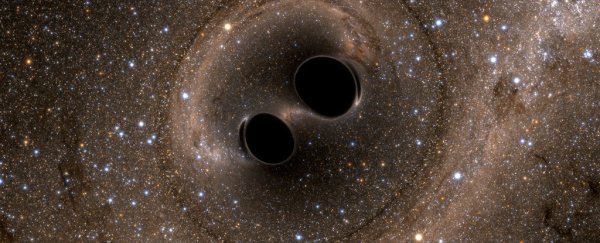Astronomers have found what looks to a fresh trove of supermassive black hole pairs, increasing the number of known pairs by about 50 percent, after new image analysis techniques were used to study two of our most detailed sky surveys.
Finding these black hole pairs is crucial to understanding more about how they form and how galaxies eventually collide, with the new findings giving astronomers five new pairs to analyse.
At the centre of the new research is the hunt for dual active galactic nuclei (AGN) - the technical term for what's formed when two supermassive black holes get caught in a death spiral after the collision of their respective galaxies.
These two black holes get closer and closer before eventually crashing into each other to form an even larger supermassive black hole, shooting out huge amounts of energy at the same time - or at least that's the current hypothesis.
Occasionally, the collision seems to send the resulting black hole speeding off through space, but that's another story.
The AGNs are formed from the massive amounts of gas and dust stirred up as a result of this black hole death spiral, causing the final, really supermassive black hole to be heavier.
Active galactic nuclei can form around any black hole, giving us a better chance of spotting them from Earth, but to understand how all this works, we need to find more of them.
"Our model of the universe tells us [AGNs] should be there, but we have failed miserably to find them," lead research Sara Ellison from the University of Victoria in Canada told New Scientist.
Ellison and her colleagues looked at the WISE All Sky Survey and the Sloan Digital Sky Survey for their work, hunting for signs of recent galaxy collisions as well as high readings from the infrared part of the spectrum, which indicates lots of dust.
Further confirmation was found from luminosity measurements taken by the Chandra X-ray Observatory. The new technique turned up five new examples of dual AGNs, to add to the nine that had already been confirmed by X-ray studies.
That's "a significant new haul", write the researchers, and there could be more on the way.
We should point out that the research has yet to go through the peer-review process, so further confirmation of the findings is needed before they're confirmed, but this could end up being a very useful way of detecting more of these AGNs.
Once astronomers know where they are, they can study how they evolve, and how the resulting supermassive black holes grow.
These AGNs could also teach us more about gravitational waves, another after-effect of a collision of two black holes: or at least they will when the shock reaches us, in tens of millions of years.
The research has been published on the preprint website arXiv.org.
